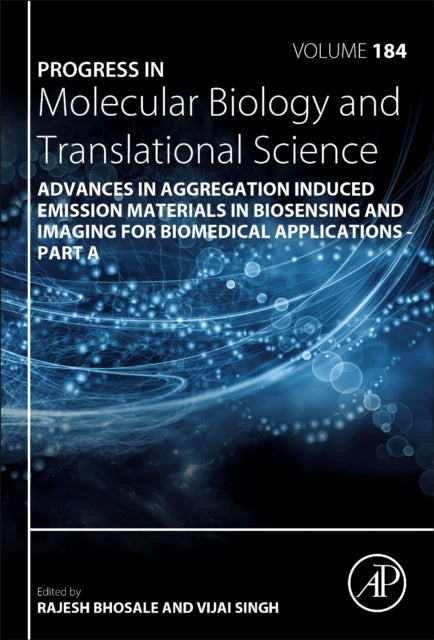Shulph Ink
Advances in Aggregation Induced Emission Materials in Biosensing and Imaging for Biomedical Applications - Part A
Advances in Aggregation Induced Emission Materials in Biosensing and Imaging for Biomedical Applications - Part A
- Condition: Brand new
- UK Delivery times: Usually arrives within 2 - 3 working days
- UK Shipping: Fee starts at £2.39. Subject to product weight & dimension
Bulk ordering. Want 15 or more copies? Get a personalised quote and bigger discounts. Learn more about bulk orders.
Couldn't load pickup availability
- More about Advances in Aggregation Induced Emission Materials in Biosensing and Imaging for Biomedical Applications - Part A
Advancements in Aggregation Induced Emission Materials in Biosensing and Imaging for Biomedical Applications - Part A Volume 184,covers a wide range of topics, including ACQ & AIE concept development, intracellular pH, temperature and viscosity sensing, imaging of cell membrane, lipid droplet, lysosome, and mitochondria, biosensing and Imaging of bacteria, nucleus and nucleic acid imaging.
\n Format: Hardback
\n Length: 246 pages
\n Publication date: 08 November 2021
\n Publisher: Elsevier Science & Technology
\n
Emit light is a captivating photophysical phenomenon that has captured the attention of scientists across various disciplines for centuries. In the modern era of scientific advancement, short-lived fluorescence light and its long-lived counterpart phosphorescence light have found widespread applications in chemo-sensing, bio-sensing, and bioimaging. The aggregation-induced emission (AIE) phenomenon has emerged as a powerful tool in modern science, enabling the transformation of aggregation-caused quenching (ACQ) materials into AIE active materials for a diverse range of biomedical applications, including biosensing, bioimaging, and molecular localization. This comprehensive volume explores a wide array of topics that are currently scattered across multiple publications, covering ACQ & AIE concept development, intracellular pH, temperature, and viscosity sensing, imaging of cell membranes, lipid droplets, lysosomes, and mitochondria, biosensing and imaging of bacteria, nucleus, and nucleic acid imaging.
The development of AIE materials has opened up new avenues for researchers, enabling them to explore and understand biological processes with greater precision. By harnessing the unique properties of ACQ materials, scientists can design and develop AIE active materials that exhibit enhanced fluorescence intensity, color, and stability, making them ideal for various biomedical applications. One of the key applications of AIE materials is in biosensing. These materials can be used to detect and quantify various biomolecules, such as proteins, nucleic acids, and small molecules, with high sensitivity and specificity. AIE-based biosensors have been employed in various fields, including clinical diagnostics, environmental monitoring, and food safety. For example, AIE-based sensors have been used to detect the presence of bacteria in food, which can help prevent foodborne illnesses and ensure the safety of our food supply.
In addition to biosensing, AIE materials have also found applications in bioimaging. These materials can be used to visualize the internal structure and dynamics of cells and tissues with high resolution and clarity. AIE-based bioimaging techniques have been used to study cell migration, cell proliferation, and cell signaling, among other biological processes. For instance, AIE-based imaging techniques have been used to study the effects of drugs on cancer cells, which can help in the development of new cancer treatments.
Another important application of AIE materials is in molecular localization. These materials can be used to tag and track specific molecules within cells or tissues, allowing researchers to better understand the molecular mechanisms underlying various biological processes. AIE-based molecular localization techniques have been used to study the distribution of proteins and nucleic acids in cells, which can help in the development of new drugs and therapies.
Despite the numerous advantages of AIE materials, there are still challenges that need to be addressed. One of the major challenges is the limited stability of AIE active materials, which can make them difficult to use in real-world applications. Additionally, the development of AIE materials that are compatible with living cells and tissues is still a major challenge, as these materials may have adverse effects on cellular function.
To overcome these challenges, researchers are actively exploring new materials and techniques to improve the stability and compatibility of AIE active materials. For example, researchers are developing AIE materials that are more stable under physiological conditions, which can make them more suitable for use in vivo. Additionally, researchers are developing AIE materials that are less toxic to living cells, which can make them more suitable for use in biomedical applications.
In conclusion, the development of AIE materials has revolutionized the field of biosensing and imaging for biomedical applications. These materials have opened up new avenues for researchers to explore and understand biological processes with greater precision. By harnessing the unique properties of ACQ materials, scientists can design and develop AIE active materials that exhibit enhanced fluorescence intensity, color, and stability, making them ideal for various biomedical applications. With ongoing research and development, AIE materials will continue to play a significant role in advancing our understanding of biological processes and developing new therapies for diseases.
\n Weight: 450g\n
Dimension: 229 x 152 (mm)\n
ISBN-13: 9780323907392\n \n
This item can be found in:
UK and International shipping information
UK and International shipping information
UK Delivery and returns information:
- Delivery within 2 - 3 days when ordering in the UK.
- Shipping fee for UK customers from £2.39. Fully tracked shipping service available.
- Returns policy: Return within 30 days of receipt for full refund.
International deliveries:
Shulph Ink now ships to Australia, Belgium, Canada, France, Germany, Ireland, Italy, India, Luxembourg Saudi Arabia, Singapore, Spain, Netherlands, New Zealand, United Arab Emirates, United States of America.
- Delivery times: within 5 - 10 days for international orders.
- Shipping fee: charges vary for overseas orders. Only tracked services are available for most international orders. Some countries have untracked shipping options.
- Customs charges: If ordering to addresses outside the United Kingdom, you may or may not incur additional customs and duties fees during local delivery.


